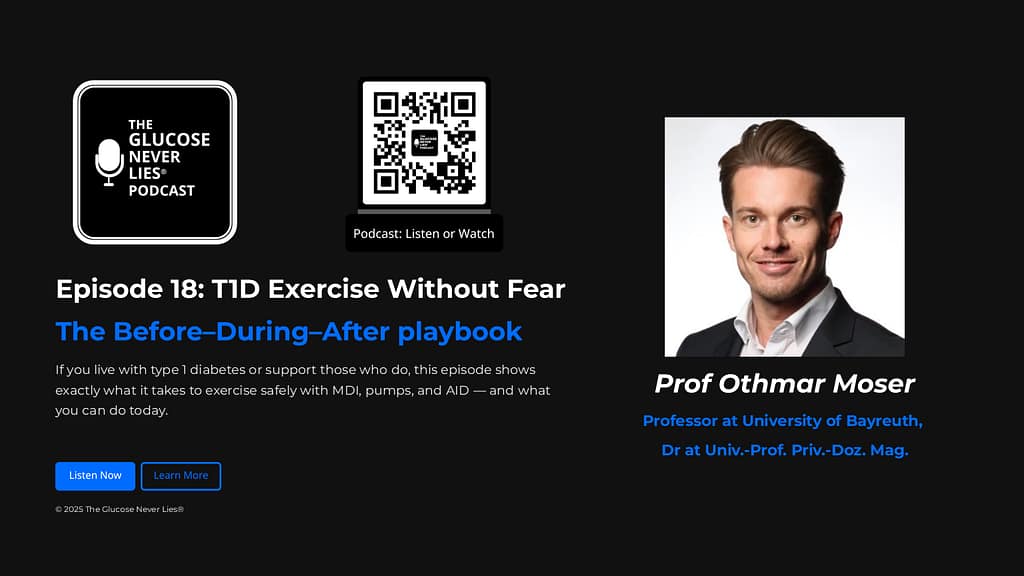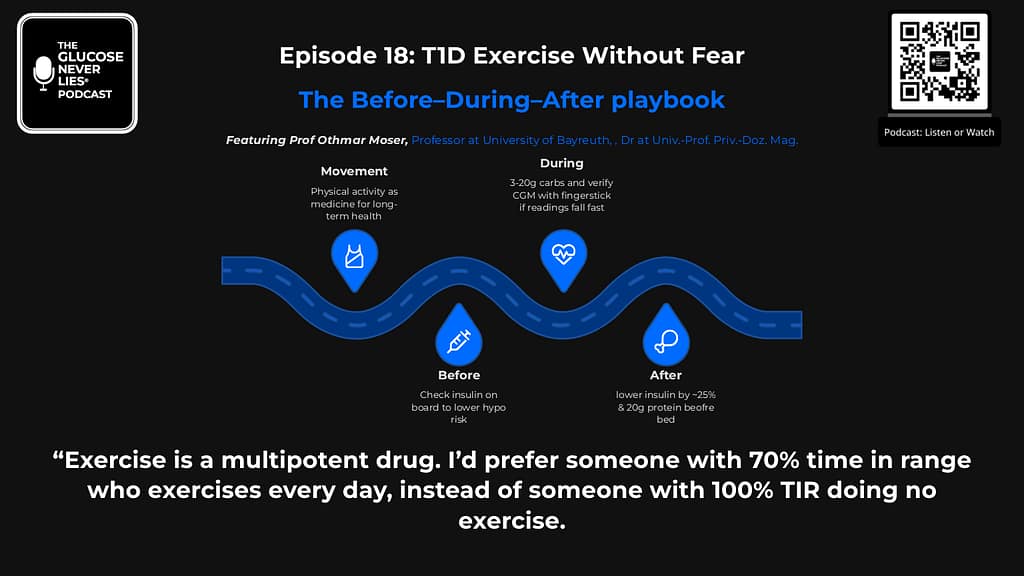Listen & watch
Prof. Othmar Moser is an exercise physiologist and guideline author in diabetes technology (CGM & AID). Living with type 1, he brings lab-grade evidence into real-world routines—from weekend walks to elite sport.


Episode overview
Guest: Professor Othmar Moser, exercise physiologist, guideline author (CGM & AID), lives with type 1 diabetes.
Host: John Pemberton, The Glucose Never Lies®.
Length: ~60 minutes
See the FAQ built on the back of this masterpiece!
What you’ll learn
- Why general movement is low hypo-risk and hugely beneficial (start with 10-minute walks post-meal).
- The Before–During–After framework for MDI, pump, and AID (CamAPS, etc.).
- How to use exercise mode/temp target and prandial reductions realistically.
- When CGM is great—and when to consider a fingerstick (e.g., double-down arrows + insulin on board).
- Night-time strategies after evening activity (temp targets, basal tweaks, 20g protein snack).
- Performance nuance: when manual mode makes sense for consistent insulin conditions.
Movement as medicine
“I’d prefer someone with 70% time in range who exercises every day, instead of someone with 100% TIR doing no exercise. Exercise is a multipotent drug.” — Prof. Othmar Moser
Before exercise — insulin on board
“The earlier you start the exercise mode in an AID system, the lower the hypo risk. Insulin on board is one of the main drivers of hypoglycemia.” — Prof. Othmar Moser
During exercise — CGM vs reality
“CGMs are extremely accurate when you’re lying in bed. But during exercise, with insulin on board and arrows down, you can be 10 mmol/L off. That’s when a fingerstick matters.” — Prof. Othmar Moser
After exercise — protein strategy
“Most people don’t go low during exercise — the highest risk is the first hour afterwards, and again at 2 a.m. if you train late. A simple 20 grams of protein before bed can make the difference.” — Prof. Othmar Moser
Big picture — priorities in type 1
“Glucose control is important, but it’s not everything. The old type 1s I see who are thriving at 80 are the ones who stayed physically active their whole lives.” — Prof. Othmar Moser
Quick takeaways
- Post-meal movement wins: 10 minutes after each meal flattens the peak and builds confidence.
- Insulin on board is king: starting exercise with high IOB drives hypos; start exercise mode ~2 h before if you can; 1 h still helps.
- Prandial reductions: if eating <2 h pre-exercise, reduce bolus ~25% (start point), then fine-tune. Ideally, keep the meal within 1 hour to prevent glucose spikes

- During: aim 7–10 mmol/L (126–180 mg/dL); top-up carbs 3–20 g based on trend/therapy; check every 20–30 min.
- Double-down arrows + <7 mmol/L? Consider a quick fingerstick—exercise increases CGM lag risk.
- After: the highest hypo risk is the first hour post-exercise; keep a higher target/ reduced basal ~2 h. Evening sessions can drop you at ~2 a.m.
- Overnight helpers: 20 g protein pre-bed for a gentle rise; or modest carbs if not on AID.
- Big picture: 70% TIR + daily activity often beats 100% TIR with no activity for long-term health.
Chapter guide
- 00:00 Intro & why the show exists
- 01:30 Meet Prof. Othmar Moser
- 06:00 How consensus guidelines are made (and why they’re practical, not perfect)
- 11:00 The exercise discs: planned vs unplanned; insulin & carb logic
- 17:00 Before exercise: temp targets, prandial reductions, timing your meals
- 25:00 During exercise: ranges, carb top-ups, CGM vs fingerstick
- 35:00 After exercise: the first hour, evening drops, protein strategy
- 45:00 AID nuance: manual mode for consistency; hybrid solutions for athletes
- 52:00 Future: faster insulins, fully closed loop, glucagon co-hormone systems
- 57:00 Q&A highlights + wrap-up & key messages
Resources mentioned
- AID position papers (2025)
- CGM position papers (2020)
- GNL Exercise Guide
- GNL AID and Exercise Guide
- GNL CGM Guide
- GNL AID Guide
AID Disks from the consensus and what I use in clinic thanks to Anjanee Kohli
Disclaimers
- This podcast is for informational purposes only and does not constitute medical advice.
- Always consult your own healthcare professional before changing therapy.
Credits
Prepared by John Pemberton, supported by AI assistant (“Chad”).
Ideas, insights, and responsibility remain with John.
Support
If this helped you or your clinic, please Buy Me a Coffee or share it with one friend who’ll benefit.
Support the GNL Podcast





